What Group of People Is Shown in Raphael's Fresco the School of Athens?
Have you ever wondered what it would be like to attend a special school, set in Classical times, surrounded by other high thinkers, scholars, and philosophers? Maybe you are not too sold on wearing a tunic though, however, we can appreciate it from our Modern viewpoint. We are speaking of one of the most well-known paintings from the Renaissance by an artist we are all familiar with, The School of Athens by Raphael. This is the painting we will discuss further in the article below.
Table of Content
- 1 Artist Abstract: Who Was Raphael?
- 2 The School of Athens by Raphael in Context
- 2.1 Contextual Analysis: A Brief Socio-Historical Overview
- 3 Formal Analysis: A Brief Compositional Overview
- 3.1 Subject Matter
- 3.2 Color and Light
- 3.3 Perspective
- 3.4 Interesting Facts and Symbolism
- 4 A Stanza with a View
- 5 Frequently Asked Questions
- 5.1 Who Painted The School of Athens?
- 5.2 Where Is The School of Athens Housed?
- 5.3 What Does The School of Athens Painting Symbolize?
- 5.4 What Is Plato's Gesture in The School of Athens, and What Is Meant By It?
- 5.5 Why Were the Greek God Apollo and the Goddess Athena Included in The School of Athens?
Artist Abstract: Who Was Raphael?
Raphael's full name was Raffaello Sanzio da Urbino, he was born in March 1483 in Urbino, a city in Italy, which was also a central city. His father, who painted for Duke Federigo da Montefeltro, taught him painting. He is also believed to have been a pupil of Pietro Perugino, a well-known painter from the Umbrian School.
Raphael also lived and worked in Florence and Rome for significant periods of his life, which also informed and influenced his artistic style.
He was known for creating a personal style characterized by a skillful utilization of colors and compositional elegance. He was commissioned by the Pope to paint in the Vatican Palace, creating a series of frescoes that were part of his major artworks. Raphael was known as a pleasant man and easily socialized with others.
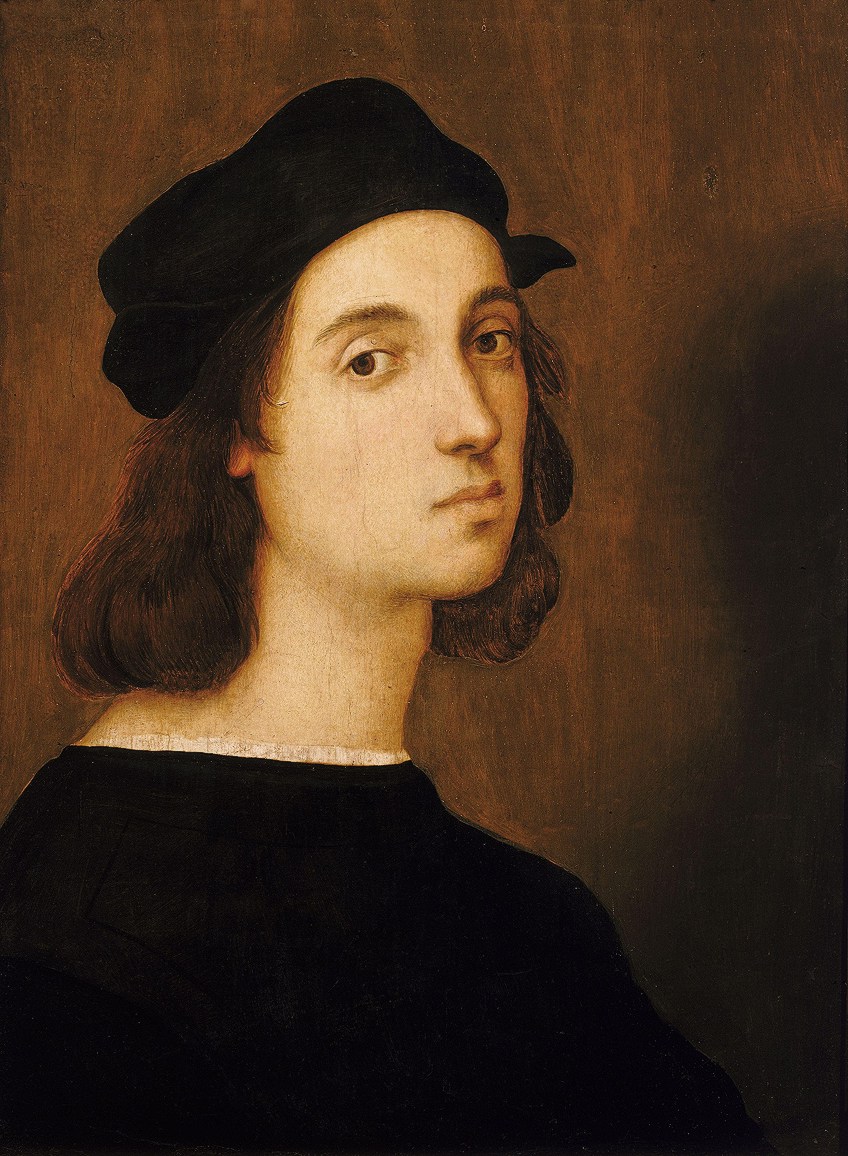 Presumed self-portrait of Raphael, aged approximately 23, between 1504 and 1506;Raphael, Public domain, via Wikimedia Commons
Presumed self-portrait of Raphael, aged approximately 23, between 1504 and 1506;Raphael, Public domain, via Wikimedia Commons
The School of Athens by Raphael in Context
Raphael, who painted The School of Athens around the years 1509, was amongst some of the High Renaissance masters, he was one of "The Big Three", namely Leonardo da Vinci and Michelangelo. His iconic painting has lived on for hundreds of years and is now among one of the most revered Renaissance paintings. This article will discuss The School of Athens analysis by first providing a contextual background.
We will discuss the period Raphael painted in, notably the High Renaissance, as well as why he painted it.
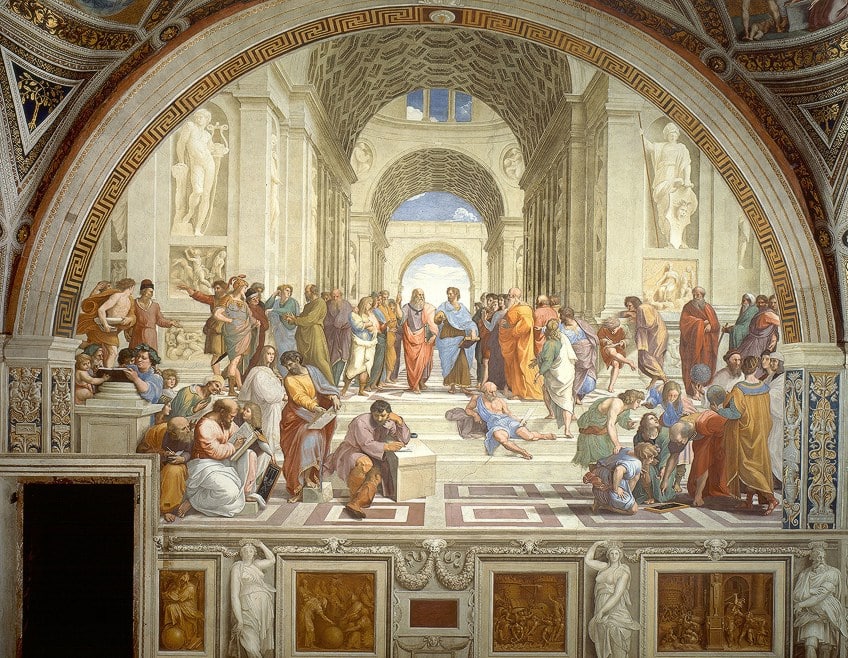 The School of Athens (1509–1511) by Raphael, fresco at the Raphael Rooms, Apostolic Palace, Vatican City;Raphael, Public domain, via Wikimedia Commons
The School of Athens (1509–1511) by Raphael, fresco at the Raphael Rooms, Apostolic Palace, Vatican City;Raphael, Public domain, via Wikimedia Commons
We will then discuss the formal elements of The School of Athens painting by looking at the subject matter, Raphael's utilization of color, line, and perspective. We will also answer some interesting questions, for example: what is Plato's gesture in The School of Athens, and what is meant by it? Why were the Greek god Apollo and the goddess Athena included in The School of Athens? All part and parcel of what makes this painting so unique. Let us look further.
| Artist | Raffaello Sanzio da Urbino (Raphael) |
| Date Painted | c. 1509 to 1511 |
| Medium | Fresco painting |
| Genre | History painting |
| Period / Movement | High Renaissance |
| Dimensions | 500 x 770 centimeters |
| Series / Versions | Part of the Stanza della Segnatura series of frescoes |
| Where Is It Housed? | Stanza della Segnatura, Vatican Museums, Vatican City, Italy |
| What It Is Worth | Not available |
Contextual Analysis: A Brief Socio-Historical Overview
Raphael moved to Rome during the year 1508, this was the third phase of his life as it has been described by the Italian historian and writer, Giorgio Vasari. The first phase was in Umbria and the second phase was most likely from around 1504 up until 1508.
During Raphael's time in Umbria and Florence, his artistic styles developed and changed. In Umbria, he was known to have two prominent teachers, namely, Timoteo Viti and Pietro Perugino. During his time in Umbria, he also received several commissions for altarpieces, for example, Coronation of the Virgin (1502) and The Marriage of the Virgin (1504).
 The Marriage of the Virgin (1504) by Raphael;Raphael, Public domain, via Wikimedia Commons
The Marriage of the Virgin (1504) by Raphael;Raphael, Public domain, via Wikimedia Commons
He was influenced by various great artistic names during his Florence years. The familiar names of Leonardo da Vinci and Michelangelo, who were also artistic "rivals" as they have been known. The techniques da Vinci utilized, sfumato and chiaroscuro, became some of the techniques Raphael also applied to his paintings.
He was known for creating a unique personal style; however, he also ruffled some feathers and was accused of stealing these techniques and styles.
During Raphael's time in Florence, he painted pieces like La belle jardinière (1507) and The Entombment (1507). The latter painting has been known as closely resembling that of Michelangelo's paintings of the same subject matter and a testament to how Raphael as an artist experimented and gained inspiration from these other artists.
 La Belle Jardinièr (The Virgin and Child with Saint John the Baptist) (1507) by Raphael;Raphael, Public domain, via Wikimedia Commons
La Belle Jardinièr (The Virgin and Child with Saint John the Baptist) (1507) by Raphael;Raphael, Public domain, via Wikimedia Commons
Raphael's life in Rome, as mentioned, started around 1508. He was reportedly invited by the then Pope Julius II (1503 to 1513) to paint the interior walls of the Pope's palatial suites. The artist ended up living in Rome and painted for the successive Pope Leo X (1531 to 1521).
The School of Athens painting was part of the commissioned artworks by Pope Julius II when Raphael moved to Rome. The Italian architect Donate Bramante was believed to have recommended Raphael to the Pope as he was working on the architectural plans for the redesign of the St. Peter's Basilica (c. 1506 to 1626). This is also when Michelangelo was painting the Sistine Chapel's ceilings for the Pope.
Apparently, the Pope ordered Raphael to remove and paint over existing frescoes that were on the walls. The older frescoes were by notable artists like Pietro Perugino, Pierro della Francesca, and Luca Signorelli.
The Four Stanze and the Pope's Library
While Michelangelo was busy with the Sistine Chapel, Raphael got to work decorating what was the private suites, otherwise referred to as the "Papal Apartments" of the Pope. Four rooms were set for decorations also known as the "Raphael Rooms" or Stanze di Raffaello. These rooms, or as they say in Italian, stanze, were namely, Sala di Costantino ("Hall of Constantine"), Stanza di Eliodoro ("Room of Heliodorus"), Stanza dell'Incendio del Borgo ("The Room of the Borgo Fire"), and Stanza della Segnatura ("Room of the Segnatura").
 Stanza della Segnatura ("Room of the Signatura"), Raphael Rooms, Apostolic Palace, Vatican City; 0ro1, CC BY-SA 3.0, via Wikimedia Commons
Stanza della Segnatura ("Room of the Signatura"), Raphael Rooms, Apostolic Palace, Vatican City; 0ro1, CC BY-SA 3.0, via Wikimedia Commons
Raphael started with the Stanza della Segnatura, which was utilized as the Pope's study with his library of a selection of books ranging from different disciplines. The books would probably have been displayed on a bookcase underneath the painting. The subject matter of The School of Athens painting, which we will discuss below, suited the purposes of the room.
Raphael painted frescoes on the walls in each stanza, namely, east, west, south, north, and the ceiling. "The School of Athens" was painted on the east wall of the "Philosophy Room", as it has also been referred to.
It was also reported to be the third painting completed after the first two, namely, Disputation of the Sacrament, otherwise known as Disputa, (1509 to 1510), which was on the west wall. The second painting was The Parnassus (1509 to 1511), which was on the north wall. The south wall depicts a lunette painting, which is titled Cardinal and Theological Virtues (1511).
Formal Analysis: A Brief Compositional Overview
As we mentioned above, the Stanza della Segnatura had a theme central to the intellectual and creative faculties of the humanities, or as it has been called, "human knowledge". These are namely, "Philosophy", "Theology", "Poetry", and "Justice". So let us take a closer look at one of the most famous frescoes from these hallowed walls and the one depicting the theme around "Philosophy", The School of Athens.
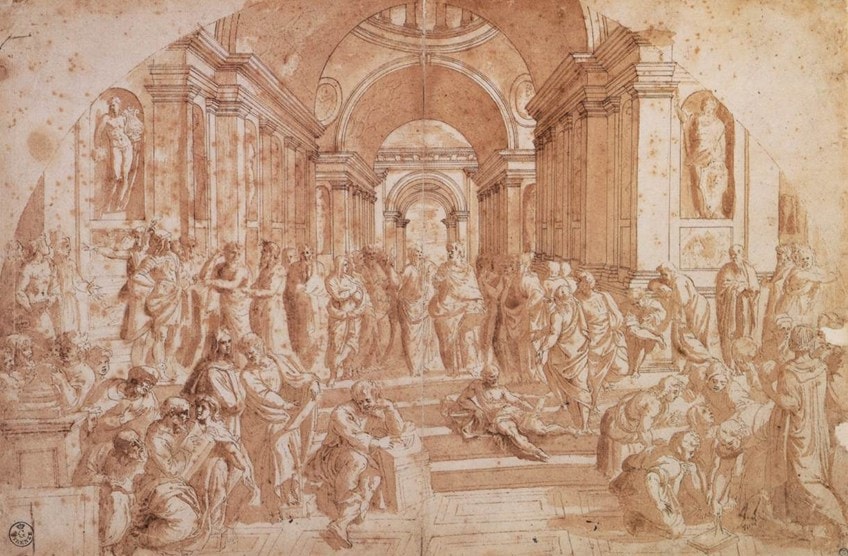 Pen and ink and wash preliminary sketch of Raphael's The School of Athens, first half of the 16th century; Raphael, Public domain, via Wikimedia Commons
Pen and ink and wash preliminary sketch of Raphael's The School of Athens, first half of the 16th century; Raphael, Public domain, via Wikimedia Commons
Subject Matter
In The School of Athens, Raphael presents a scene filled with sitting and standing men debating, contemplating, and calculating, these are all representations of some of the most important ancient and classical philosophers and scientists. They are all within a Classical Greek-inspired architectural setting. This setting has been reported to be in the design of St. Peter's Basilica that Donate Bramante, whom we mentioned earlier, redesigned.
The central figures are two of the most revered Ancient Greek philosophers, namely, Plato who is to our left, and next to him is Aristotle, to our right.
In both figures' left hands, we can see two books, namely Plato's Timaeus and Aristotle's Ethics. Both figures are also gesturing with their right hands. Plato is pointing upwards with his index finger and Aristotle's hand is raised, palm facing down and parallel to the floor as if he is going to lay his hand on something.
 Plato (left) and Aristotle (right) in Raphael's The School of Athens (1509-1510);Raphael, Public domain, via Wikimedia Commons
Plato (left) and Aristotle (right) in Raphael's The School of Athens (1509-1510);Raphael, Public domain, via Wikimedia Commons
There are dozens of figures presented here around the central two, and their exact identities have been a matter of question. Some have been identified as ancient philosophers, scholars, and scientists, but also as Raphael's acquaintances. And as we mentioned above, they all appear to be depictions of the most significant philosophers from ancient history.
Starting from the far left of the composition, we see a figure that appears quite rushed, almost running into the composition, he is looking at the figure next to him who is gesticulating to another figure. In the bottom corner, we see a man sitting right next to a child who is looking straight at us, the viewers.
This man is possibly Zeno of Citium, a Hellenistic philosopher.
 A detail of The School of Athens (1509–1511) by Raphael; Raphael, Public domain, via Wikimedia Commons
A detail of The School of Athens (1509–1511) by Raphael; Raphael, Public domain, via Wikimedia Commons
Other prominent figures in the left part of the composition include the Greek philosopher Epicurus, the man with the green crown of leaves on his head busy writing. We see Anaximander in the bottom left foreground, he was known as a pre-Socratic Greek philosopher and scientist.
Right next to him sits a man who is possibly thought to be Pythagoras and next to him sits Archimedes, who was a Greek mathematician and scientist; he is holding a board with theorem written on it (some sources also suggest this could be the Greek philosopher Anaxagoras.
Closer to the middle foreground, sitting with his head resting on his left hand (our right), a pen in his right hand (our left), a piece of paper on a slanted marble block, and an inkpot right behind his resting elbow, undoubtedly in the process of writing something is Heraclitus of Ephesus, whom Raphael also portrayed to resemble Michelangelo. He appears in deep thought.
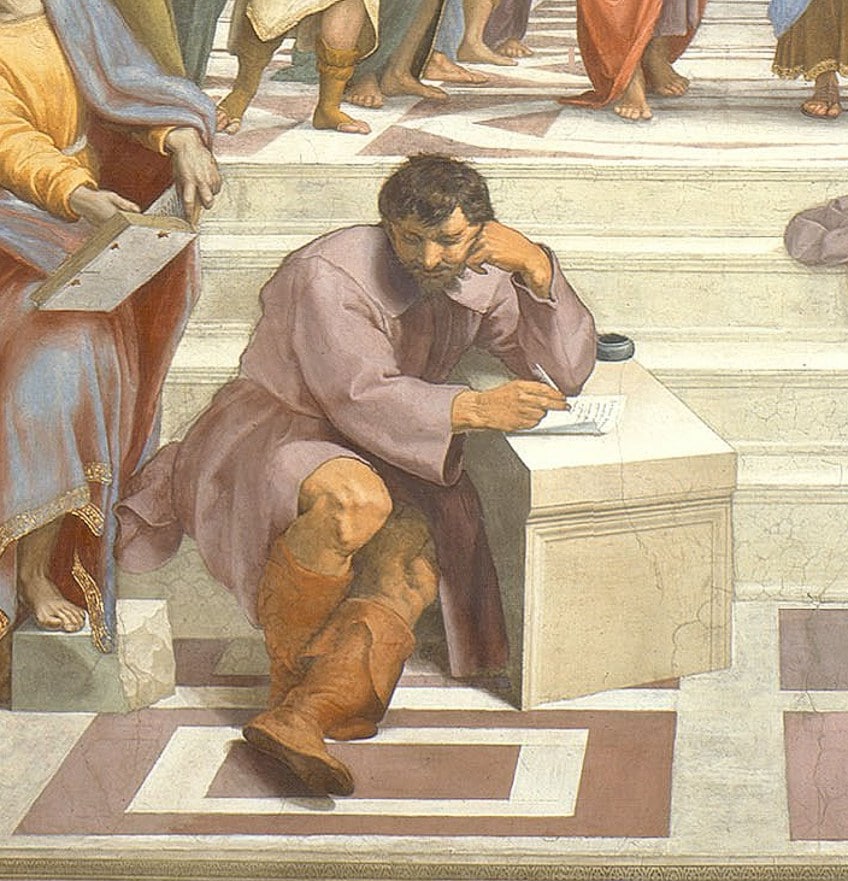 A detail of The School of Athens (1509–1511) by Raphael; Raphael, Public domain, via Wikimedia Commons
A detail of The School of Athens (1509–1511) by Raphael; Raphael, Public domain, via Wikimedia Commons
Other notable figures on the left-hand side include Socrates, who has his back to the two central figures, wearing an olive-green robe. His students were Plato and Xenophon. Standing directly opposite Socrates is either Alexander the Great or the Athenian general Alcibiades, the two appear to be discussing something.
If we look at the right-hand side of the composition, prominent figures include Plotinus, Zoroaster, Ptolemy, Euclid, and Diogenes near the middle ground. The latter appears quite relaxed, resting his right elbow (our left) on a step whilst holding up and reading a piece of paper in his left hand (our right).
It is important to note that it is not completely clear who exactly all the figures are in "The School of Athens" painting, and some may appear to be more than one person, which also becomes a matter of our judgment to decipher their identities.
Spot the Artists
Apart from portraying Michelangelo as Heraclitus, Raphael also included a self-portrait and the resemblances of other artists, namely, Leonardo da Vinci and Donate Bramante. Leonardo da Vinci is Plato and Bramante is depicted as either Pythagoras or Euclid.
Interestingly, Bramante was related to Raphael, the latter also reportedly depicted himself as Apelles of Kos, an ancient Greek painter.
We will see Raphael's face nestled in between other figures to the far right where the arch meets the pillar. He stands, wearing a black hat, next to the figure who is holding a globe up on the fingertips of his right hand. The globe appears to be a visual example of the stellar system; another figure also holds a globe of the earth.
 A detail of The School of Athens (1509–1511) by Raphael; Raphael, Public domain, via Wikimedia Commons
A detail of The School of Athens (1509–1511) by Raphael; Raphael, Public domain, via Wikimedia Commons
Background Statues
There are two statues in the background, each on opposite sides of the court area. To the far left is Apollo and to the far right is the Greek goddess Athena, who is called Minerva in Roman mythology. Apollo is the god of many things, namely, light and the Sun, archery, prophecy, truth, healing, dance, music, and more. Athena symbolizes justice, victory, law, wisdom, and strategic war.
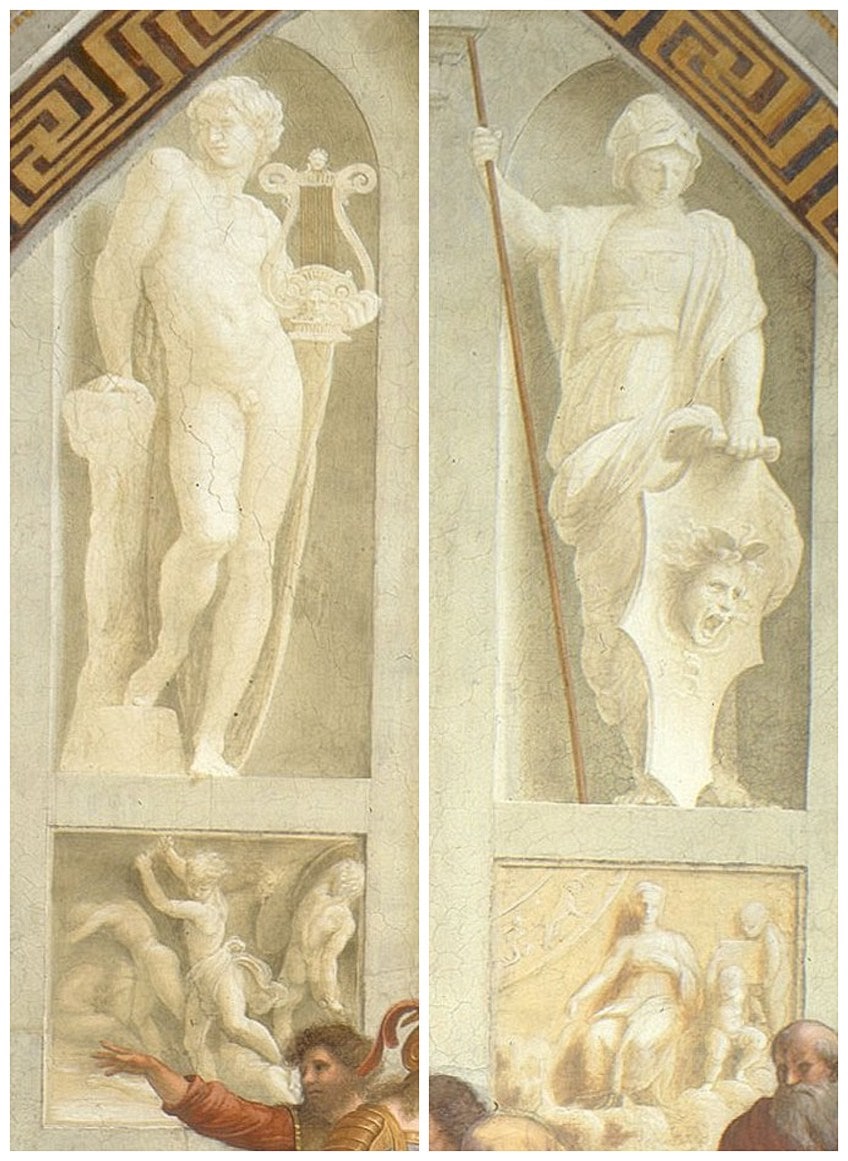 The statues in The School of Athens (1509–1511) by Raphael, with Apollo on the left and Athena on the right; Raphael, Public domain, via Wikimedia Commons
The statues in The School of Athens (1509–1511) by Raphael, with Apollo on the left and Athena on the right; Raphael, Public domain, via Wikimedia Commons
Looking at Apollo, he stands with a lyre in his left (our right) hand. He was apparently placed to the left side of the composition because in this way he was closer to the North wall painting called Parnassus, which symbolized the area of poetry in the Humanities. Similarly, Athena symbolizes philosophy and wisdom, which also corresponds to the South wall painting Cardinal and Theological Virtues depicting the theme of law.
A Little Bit More About the Architecture
As we mentioned earlier, the architectural setting is inspired by that of St. Peter's Basilica, of which the plans were redesigned by Bramante. The layout is also apparently in the shape of a Greek cross. Furthermore, the ceiling above the hall is done in the coffered barrel vault style, which is also a style we will see from Roman architecture. We also see other architectural patterns, namely a geometric band of interlocking squares, decorating the inside of the main archway in the foreground.
These are referred to as Greek Frets or Greek Key and have been common decorative patterns in Classical Greek and Roman architecture as well as pottery.
Color and Light
The entire composition of The School of Athens depicts a light-filled space. We see this especially near the background where the architectural space opens and shows us only glimpses of the blue sky and white clouds.
The color scheme utilized in this fresco is generally light. Raphael did not utilize dark tones and remained with softer and as described "muted" colors, especially in the various colors from the men's robes. This is an indication of how Raphael utilized the sfumato and chiaroscuro techniques.
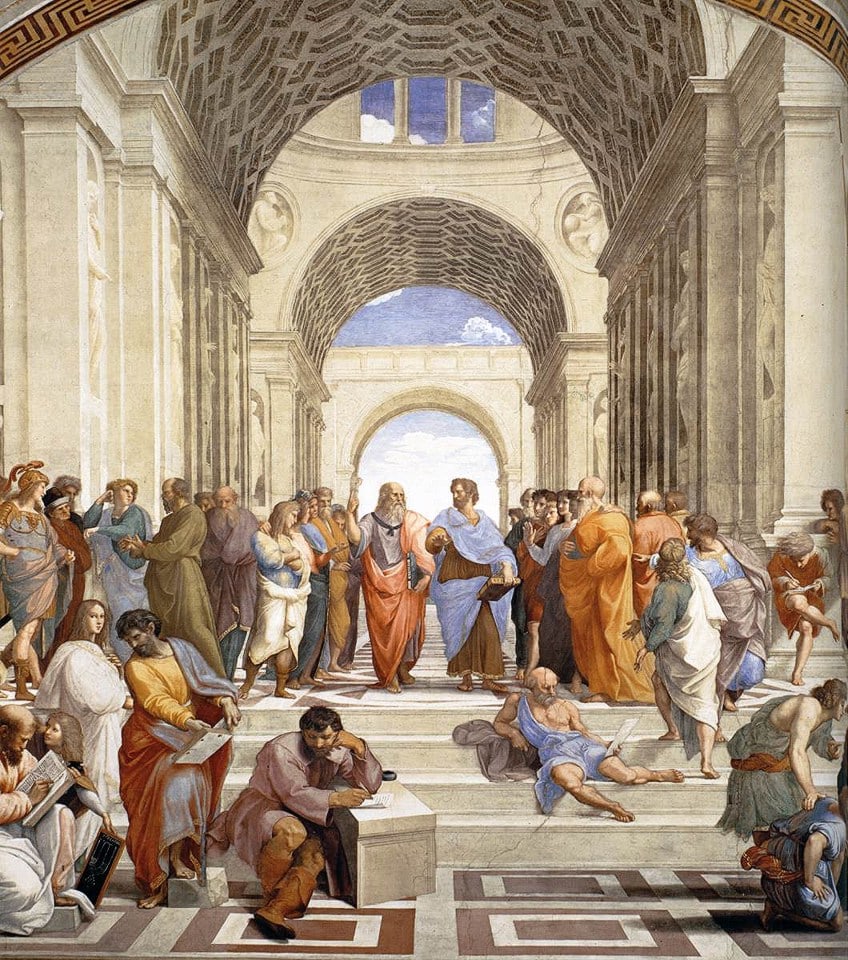 Detail of the monumental fresco done by Raphael, The School of Athens, 1509;Raphael, Public domain, via Wikimedia Commons
Detail of the monumental fresco done by Raphael, The School of Athens, 1509;Raphael, Public domain, via Wikimedia Commons
Furthermore, the subdued color tones are characteristic of Raphael's painting technique, which also leads our gaze more gently around the entire composition. Raphael also utilized color in a realistic manner to portray how the light falls from the openings in the background. The two central figures are seemingly highlighted by the archway opening directly behind them. There is also an opening above the figures, which suggests another source of light that we cannot see.
Perspective
There is much to be said about how Raphael depicted and utilized elements of space in The School of Athens painting. The use of linear perspective and a vanishing point additionally relies on his utilization of the architectural setting. Firstly, the foreground opens as if it is a stage that we can walk onto, in other words, the composition welcomes us, the viewers, to almost participate in the philosophical calculations and contemplations.
This is emphasized by the large arch almost framing the composition. It has been compared to being almost like a theater space.
We will see the horizon line falls just along with Plato's and Aristotle's head lines. We see this emphasized by the strong horizontality of all the figures placed right next to each other on the same platform that the two central figures are standing on. This horizon line also falls under the bases of the two flanking statues of Apollo and Athena.
As part of linear perspective, the orthogonal lines converge from the foreground, notably the grouping of figures in the left and right corners, to form the vanishing point. The slanted marble block also adds to the perspectival lines as they converge from below.
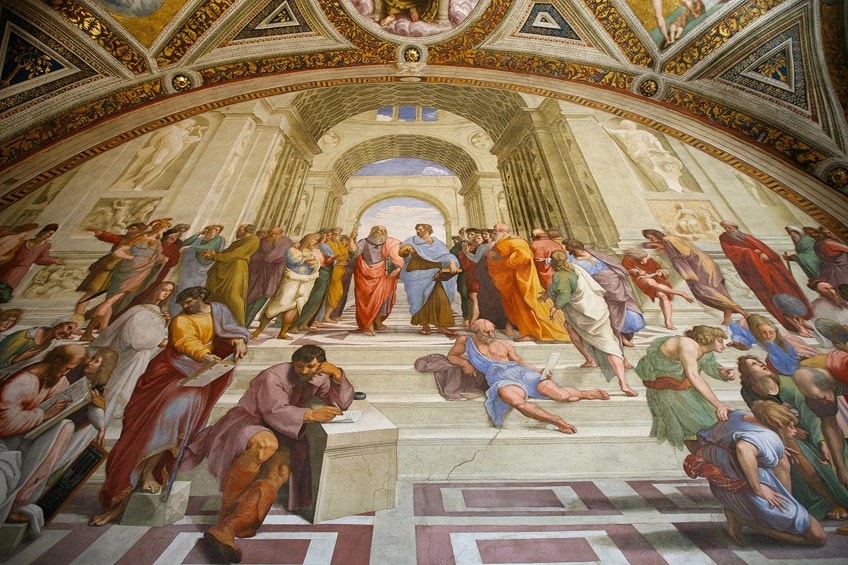 A view of The School of Athens by Raphael, illustrating the use of perspective; Alex Proimos from Sydney, Australia, CC BY 2.0, via Wikimedia Commons
A view of The School of Athens by Raphael, illustrating the use of perspective; Alex Proimos from Sydney, Australia, CC BY 2.0, via Wikimedia Commons
On the floor in the foreground, a series of squared patterns add to the spatial awareness. The vanishing point falls between the two central figures of Plato and Aristotle in the sky in the background. From above we will notice the converging lines that form as a result of the alignment of the placement of the barrel vaulting, of which there are two archways and then a third right near the end of the hall, behind our central figures.
We will also notice there is quite a large section of unfilled space in the foreground, most of the figures are either grouped to the left and right sides of the composition. Additionally, these groups are on two tiers, which consist of the four steps that run along the midsection of the hall.
This elevation of some of the figures adds to the perspective of the entire scene and possibly provides a balance to how he utilized the linear perspective.
Interesting Facts and Symbolism
While there is significant symbolism and references in The School of Athens by Raphael, an important question that pops up is, namely, what is Plato's gesture in School of Athens, and what is meant by it? We see Plato's right index (our left) is pointing to the sky, and seemingly opposing, is Aristotle's right hand in a gesture indicating towards the ground.
The hand gestures of both philosophers give clear examples of their respective philosophical beliefs. Plato points to the sky to show that he believes the "real" world is the one we are not able to see. The real world that becomes real to us through our senses is argued to be the "real" world by Aristotle, who gestures downwards.
Some of the key differences and characteristics between Plato's and Aristotle's philosophies have been described as Plato being more "abstract" and "theoretical" and Aristotle being more "practical".
 A close up of Raphael's The School of Athens (1509-1510);Jorge Valenzuela A, CC BY-SA 3.0, via Wikimedia Commons
A close up of Raphael's The School of Athens (1509-1510);Jorge Valenzuela A, CC BY-SA 3.0, via Wikimedia Commons
Their theories of Forms were based on their individual theories, for example, Plato believed that form was experienced in the mind, through ideas. Aristotle believed that forms were part of things and not "independent" of them as per Plato's belief.
Consistent with the theme of Philosophy as we discussed above, The School of Athens painting depicts references to ideas above and below, theoretical ideas and ideas based on physicality. Could we also then look at the environment surrounding the figures as a visual example of these ideas?
The architectural space could symbolize the ideas of the physical reality and the sky outside, ephemeral, and abstract, could symbolize more abstract ideas?
A Stanza with a View
In The School of Athens analysis above, we looked at various contextual and formal elements that make this fresco painting what it is. It has been a High Renaissance masterpiece and since its creation in the 1500s it received wide acclaim, in fact, numerous sources state what a success it was from the start.
The School of Athens painting has been reproduced numerous times and worth mentioning is Raphael's famous preparatory drawing of the composition, which has been displayed at the Biblioteca Ambrosiana located in Milan. Furthermore, we will find a likeness of Raphael's Renaissance version to the mosaic from Pompei titled Plato's Academy mosaic (100 BC to 79 AD).
Raphael painted during a time when great artists existed and let us not forget that Michelangelo was not too far away from him during this project painting the Sistine Chapel. He was undoubtedly influenced and inspired by not only Michelangelo's style but also the techniques of Leonardo da Vinci. Raphael's painting holds a complexity of meaning and context within and around its creation and will remain one of the best examples from the High Renaissance, giving the Stanza della Segnatura a view worth contemplating.
Frequently Asked Questions
Who Painted The School of Athens?
The School of Athens is a fresco painted by the High Renaissance artist known as Raphael, however, his full name was Raffaello Sanzio da Urbino.
Where Is The School of Athens Housed?
The School of Athens by Raphael is housed in the Apostolic Palace in the Vatican City in Rome, Italy. It is painted in one of the four "Raphael Rooms", namely, the Stanza della Segnatura ("Room of the Segnatura"), what used to be the Pope's study with a library. The other rooms were, namely, Sala di Costantino ("Hall of Constantine"), Stanza di Eliodoro ("Room of Heliodorus"), and Stanza dell'Incendio del Borgo ("The Room of the Fire in the Borgo").
What Does The School of Athens Painting Symbolize?
The School of Athens painting symbolizes Philosophy, one of the disciplines of the Humanities or areas of human knowledge, which the main room it is painted in, the Stanza della Segnatura, aims to represent. The other three paintings symbolize "Poetry", "Justice", and "Theology". In The School of Athens, we see a variety of ancient philosophers and scholars debating, contemplating, and calculating. The two central figures include the important ancient philosophers Plato and Aristotle.
What Is Plato's Gesture in The School of Athens, and What Is Meant By It?
In The School of Athens Plato's index finger of his right hand (our left) points to the sky. This is indicative of his philosophical beliefs, which focus on more abstract ideas and that reality exists in the "realm" of the spiritual world. This is compared to Aristotle's gesture beside him, which gestures to the earth below, indicative of his beliefs that reality is in the physical form. Plato's hand gesture could be referring to his philosophy called the "Theory of Form".
Why Were the Greek God Apollo and the Goddess Athena Included in The School of Athens?
The Greek god Apollo and the goddess Athena represent aspects that relate to the overall theme of the room The School of Athens painting is housed in, the Stanza della Segnatura, which was originally a study with the Pope's library. Apollo is the god of dance, music, archery, prophecy, truth, and more. Athena, Minerva in Roman mythology, is the goddess of wisdom and war, which suited the many disciplines of the Humanities, namely, Philosophy, Poetry, Justice, and Theology, in the Pope's study.
What Group of People Is Shown in Raphael's Fresco the School of Athens?
Source: https://artincontext.org/the-school-of-athens-raphael/
0 Response to "What Group of People Is Shown in Raphael's Fresco the School of Athens?"
Post a Comment